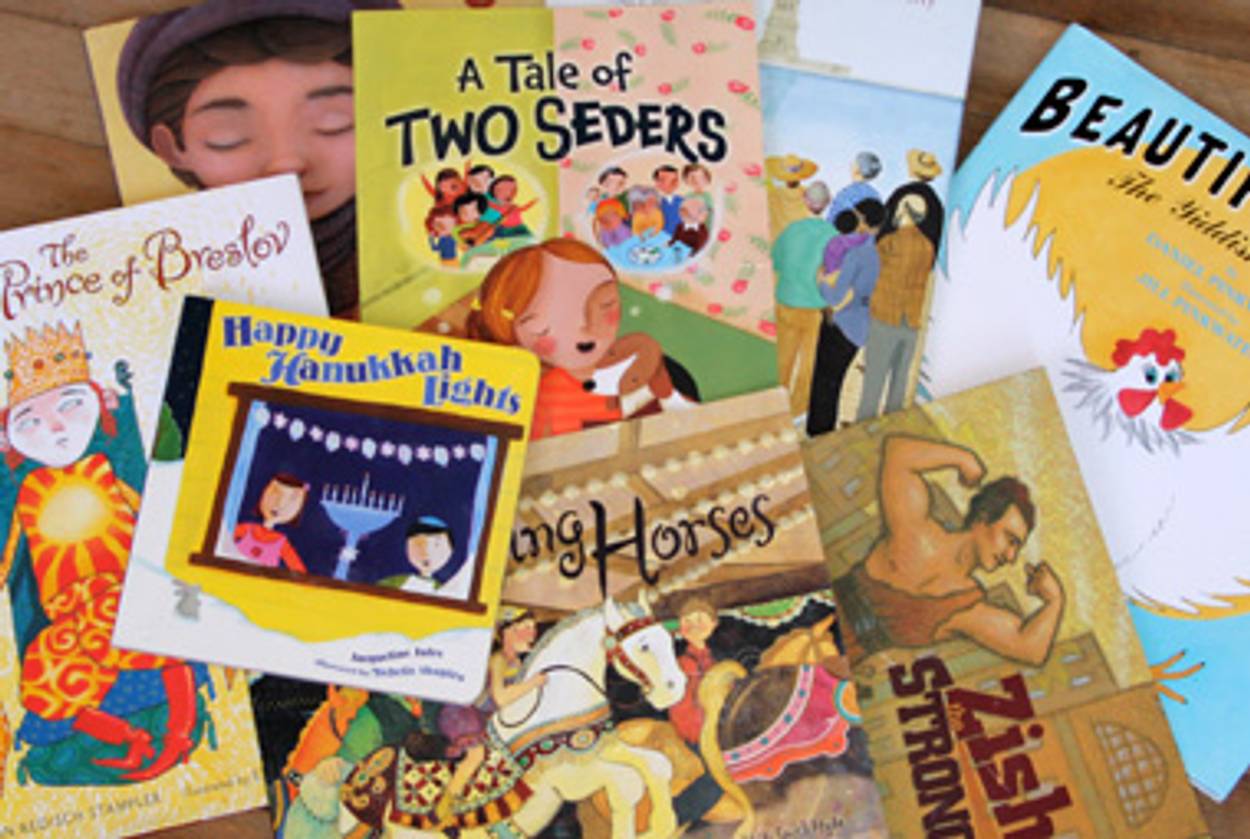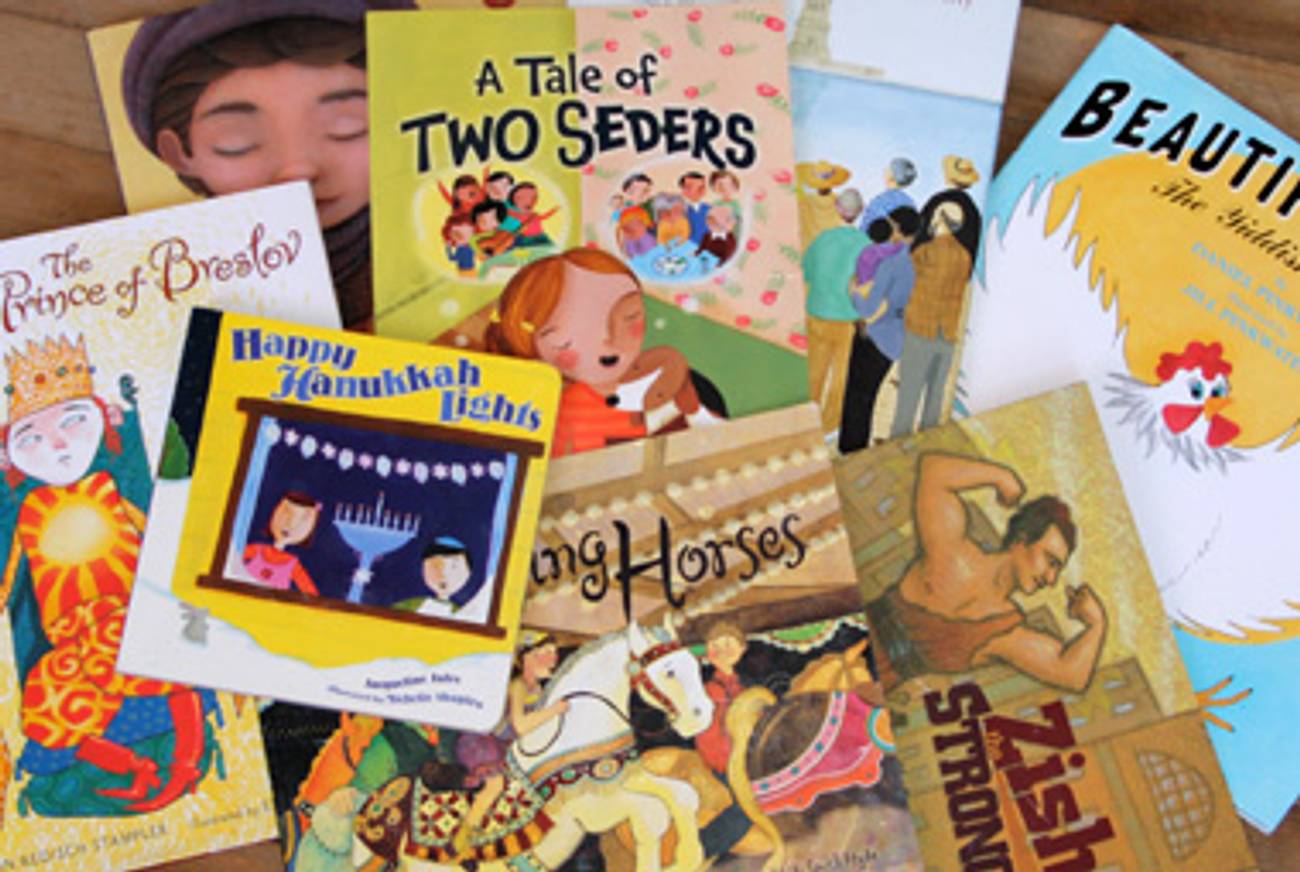Children of the Book
As Hanukkah approaches, a look at the year’s best Jewish picture books




Perhaps you’ve heard: We Jews love books. And we like to indoctrinate the little Jews. So, why not give a kid a picture book for Hanukkah? It comes early this year, which means my annual rundown of the best Jewish children’s books of the year is early too. Behold your idiosyncratic gifting guide: Some of the choices will appeal to the littlest kids; some are for older elementary schoolers, and next week we’ll look at the year’s best Jewish chapter books and graphic novels.
My favorite Jewish picture book this year, by far, is Beautiful Yetta, the Yiddish Chickenby Daniel Pinkwater and illustrated by Jill Pinkwater. This multi-culti immigration fantasy is funny and sweet. Written in simple, poetic sentences, it is the story of Yetta, who will not be soup. After being delivered to Phil’s Poultry World, she escapes and finds herself on the streets of Brooklyn. The pigeons are unhelpful schmucks. All seems lost until she rescues a parrot from cat-related disaster, and suddenly Yetta has friends to show her the ropes of city life. She speaks only Yiddish and her new parrot friends speak only Spanish (there are translations), making this book hilarious to read out loud, especially if you speak neither language. My 6-year-old now wanders around the house exclaiming “Gevalt!” and cooing “Meyn teyehreh kinder!” at her stuffed animals. The Yiddish feels organic to the plot, not grafted-on. (Recommend for ages 4-8).
The Rooster Prince of Breslov by Ann Redisch Stampler and illustrated by Eugene Yelchin, is a more traditional poultry-driven story—it’s based on an old folktale attributed to Rabbi Nachman of Breslov—with edgier, funkier illustrations. In this one, the prince suddenly decides he’s a rooster, rips off his clothes, and starts pecking around on the floor. The king and queen are at wits’ end until a mysterious, frail old man shows up and works wonders. Stampler retells the fable beautifully, and I love the oddball art. (Ages 5-9)
On the board-book front, Happy Hanukkah Lightsby Jacqueline Jules and illustrated by Michelle Shapiro, is a fine choice despite its lack of poultry (actual or delusional). Saying “It’s better than Happy Hanukkah, Corduroy” is not the most rousing recommendation, but hey, it’s also better than Biscuit’s Hanukkah. Unlike some other books for the very wee, it mentions Judah Maccabee, the folk-arty illustrations are appealing, and the couplets actually scan: “Our smiles spin from face to face/ Like dreidels by the fireplace.” Plus the daddy is the one making the latkes. (Ages 1-4)
There are some kids—frequently boys—who love “true books.” For them, there’s Zishe the Strongman, by Robert Rubinstein and illustrated by Wendy Miller. Zishe, born Siegmund Breitbart in 1883, was a Polish Jew who toured the world demonstrating his strength—bending iron bars with his bare hands, cracking Brazil nuts between his fingers, pulling a wagonload of people down Fifth Avenue by his teeth. But Zishe was sensitive, too, playing his cello for hospitalized children and meeting with the Jewish community everywhere he went. The sepia-toned illustrations have a soft-edged, wistful, pencil-y feel, but with a cartoony zing that keeps them from looking too “historical” and therefore boring. (Ages 5-8)
Another wonderful nonfiction book is Emma’s Poem: The Voice of the Statue of Libertyby Linda Glaser and illustrated by Claire Nivola. We don’t get many historical portraits of wealthy American Jews in children’s books. So, the notion of Emma Lazarus—the rich, artistic 19th-century lady who wrote the poem inscribed on the base of the Statue of Liberty—caring about the fate of poor immigrants is appealing, and Glaser wisely focuses on explicating the famous last five lines of “The New Colossus” (the entire sonnet is reprinted in the back), which are the easiest for kids to understand. Plus, the painterly illustrations are so full of wonderful texture and detail that budding fashion and interior designers will plotz. (Ages 5-10)
Yet another story set in the late 19th century was a big hit with my younger daughter Maxie. Feivel’s Flying Horses by Heidi Smith Hyde and illustrated by Johanna van der Sterre is a dreamy little tale about immigration, this time from the perspective of a member of the huddled masses. Feivel, a woodcarver of ritual objects in the Old Country, leaves his beloved family behind to create a better life for them in America. He apprentices to a Coney Island merry-go-round maker, and every horse he makes is a tribute to a member of his family. In tiny letters, he carves his loved ones’ names into the saddles. Maxie’s favorite is the little pony covered in glittering glass jewels that Feivel makes for his baby Lena, who, he notes sadly, “was no longer a baby.” Finally Feivel finishes the carousel and can afford to send for his family. Reunited, they ride around and around. You get familial love, Coney Island, fancy horses, sorrow and sweetness. What’s not to like? A note in the back discusses the many Jewish artisans who became carousel artists in the late 1800s and early 1900s. (Ages 4-8)
And, hey, look, a contemporary story! A Tale of Two Seders by Minda Avra Portnoy and illustrated by Valeria Cis is about life after divorce. A little girl tries to get used to having a seder in each parent’s house (she notes that Passover, with its two seders, is “a lot easier than Thanksgiving, when there’s also lots of food but you have to decide where to eat it”). While she longs for her parents to get back together, she also comes to understand that “families are like charoset. Some have more ingredients than others, some stick together better than others, some are sweeter than others. But each one is tasty in its own way.” (In context, the quote isn’t as sappy as it sounds.) The brightly colored art, full of pattern and delightful outfits, does its part to keep sorrow at bay. Figures that the author of Where Do People Go When They Die?, one of the best Jewish children’s books about death, wrote an honest and bittersweet book about another tough topic. (Ages 4-8)
It’s been a good year for Pesach books. Passover: Celebrating Now, Remembering Then, by Harriet Ziefert, is ravishing—it’s like an illuminated manuscript in children’s book form. Illustrator Karla Gudeon is also a fine-art painter and ketubah artist. Her work’s the star here—the two-page spread of the Israelites crossing the Red Sea is breathtaking, alive with color and movement. There are flaps to lift, showing the differences between “then” (the story of the Exodus) and “now” (what we do to commemorate it today), so there’s a bit of interactivity to keep kids engaged. I could see the book standing in for a Haggadah for minimally observant families, but I think it would be welcome on anyone’s coffee table. (Ages 4-10)
I’m not sure why Howard Schwartz isn’t a bigger rock star. I couldn’t find a single copy of Gathering Sparks in any bookstore in Manhattan. A shandeh. Schwartz’s 2005 collaboration with illustrator Kristina Swarner, Before You Were Born, made my best-books list at the Forward that year. It’s now out of print. Another shandeh. Both books are serene, lovely, intimate—perfect bedtime books. In Gathering Sparks, told in the second person, you are a child asking your grandfather about how the stars came to be. He tells you the story of God filling vessels with light, the vessels shattering, the responsibility we all share to gather the sparks and heal the world. “For every good deed you do, one of those hidden sparks rises up and a little bit of the world is repaired,” the grandfather tells you. Again, Swarner’s radiant, hazy, mixed-media paintings work perfectly with Schwartz’s poetic text. The stars blend with the flowers and look like fireflies dancing around the storyteller and listener. Tikkun Olam is beautiful, and so is this book. (Ages 4-8)
Be sure to check back next week for the second half of the list—chapter books and graphic novels.
Marjorie Ingall is a columnist for Tablet Magazine, and author of Mamaleh Knows Best: What Jewish Mothers Do to Raise Successful, Creative, Empathetic, Independent Children.
Marjorie Ingall is a former columnist for Tablet, the author of Mamaleh Knows Best, and a frequent contributor to the New York Times Book Review.